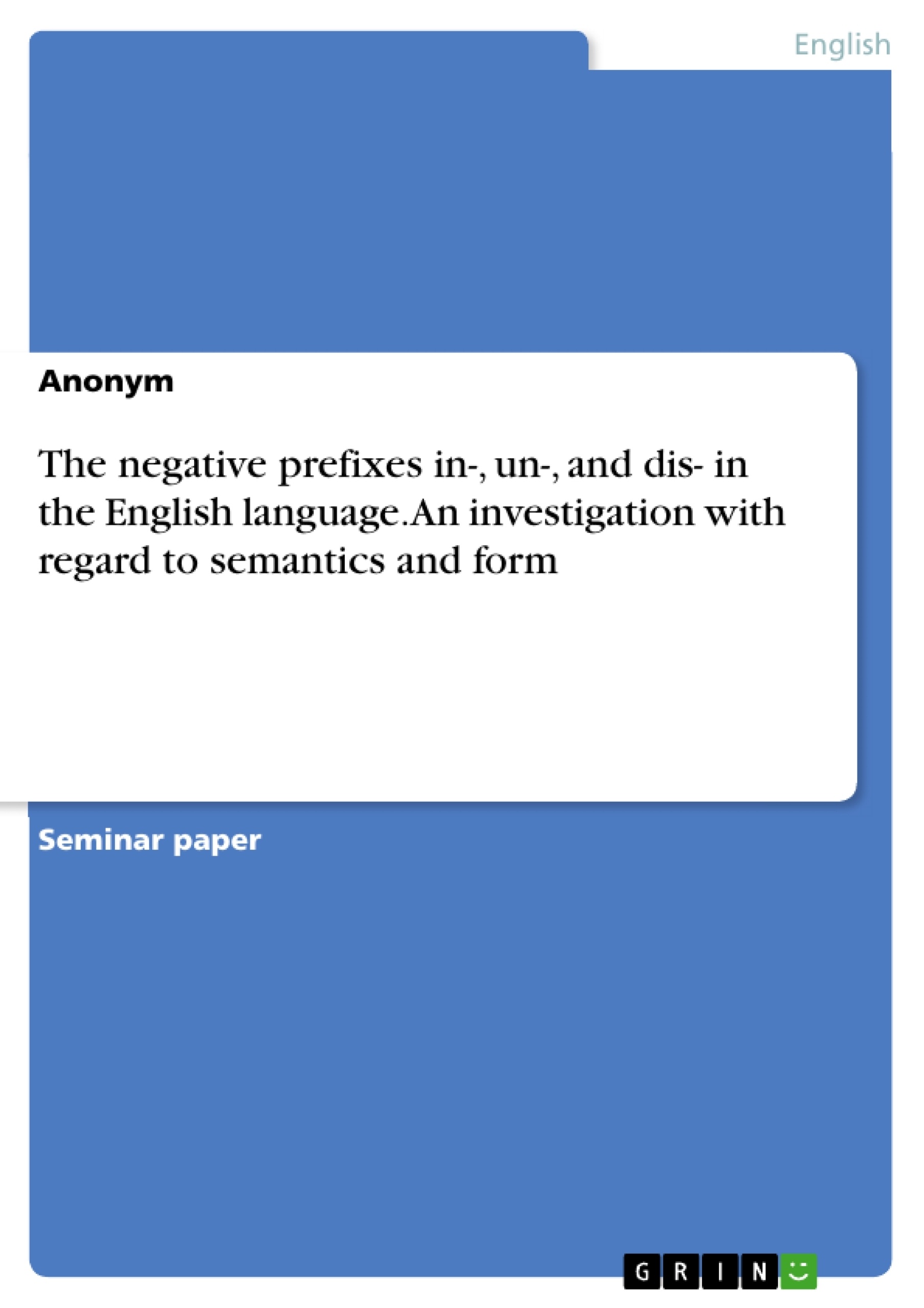This analysis serves to find out whether these prefixes express different nuances of negativity. Do they have a meaning on their own or can they be considered synonymous as they all denote negativity?
The negative prefixes in-, un- and dis- are all used to alter an affirmative statement into a negative one in order to signal oppositeness. They are considered rival prefixes. However, Bauer et al. point out that the attachment of different negative prefixes to the same base creates derivatives which are often not only formally but also semantically different.
Table of Contents
- 1 Introduction
- 2 Literary Review
- 2.1 Negative prefixes and their rivalry
- 2.2 Types of negativity
- 3 Corpus Study
- 4 Conclusion
Objectives and Key Themes
This study aims to investigate the nuances of negativity expressed by the English negative prefixes in-, un-, and dis-. It explores whether these prefixes possess independent meanings or are synonymous, focusing on their application to nominal and adjectival bases. The analysis also examines the productivity of these prefixes and the factors determining their acceptability with different bases.
- Nuances of negativity expressed by in-, un-, and dis-
- Productivity of negative prefixes in English
- Semantic and formal differences in derivatives formed with rival prefixes
- Factors influencing the acceptability of prefix-base combinations
- Different types of negation (contradictory, contrary, stereotype, privative)
Chapter Summaries
1 Introduction: This introductory chapter establishes the research question concerning the semantic distinctions and productivity of the English negative prefixes in-, un-, and dis-. It highlights the historical development of these prefixes in English, noting the introduction of in- and dis- after the Norman Conquest, leading to new word-formation patterns. The chapter emphasizes the need to analyze the semantic nuances of these prefixes, investigating whether they are truly synonymous or exhibit subtle differences in meaning when applied to nominal and adjectival bases. The limited scope of the analysis, focusing on nominal and adjectival derivatives, is also justified.
2 Literary Review: This chapter delves into the existing literature on negative prefixes and their rivalry. It defines prefixes and negation, distinguishing between syntactic and morphological negation. The concept of "rival affixes" is introduced, explaining how prefixes with the same semantic effect (negation) can co-exist and sometimes differentiate semantically over time. The chapter explores different types of negation, including contradictory and contrary negation, stereotype negation, and privative negation. It discusses how the choice of prefix can impact the meaning of the derivative word, highlighting the importance of considering the base word's semantic qualities and context in determining the type of negation employed. The chapter concludes by summarizing potential semantic interpretations associated with the prefixes in-, un-, and dis-.
Keywords
Negative prefixes, in-, un-, dis-, negation, morphology, semantics, productivity, word formation, rival affixes, contradictory negation, contrary negation, stereotype negation, privative negation, British National Corpus.
Frequently Asked Questions: A Comprehensive Language Preview of English Negative Prefixes
What is the main topic of this language preview?
This preview comprehensively examines the nuances of negativity expressed by the English negative prefixes in-, un-, and dis-. It investigates whether these prefixes are synonymous or possess independent meanings, focusing on their application to nouns and adjectives. The study also explores the productivity of these prefixes and the factors influencing their acceptability with different word bases.
What are the key themes explored in this study?
The key themes include the subtle differences in negativity expressed by the three prefixes, the productivity of negative prefixes in English, semantic and formal differences in words formed using these prefixes, factors influencing the acceptability of prefix-base combinations, and different types of negation (contradictory, contrary, stereotype, privative).
What is the structure of the language preview?
The preview is structured into four chapters: an introduction, a literature review, a corpus study (not fully detailed in this preview), and a conclusion. The preview itself provides a table of contents, objectives and key themes, chapter summaries, and keywords.
What does the introduction cover?
The introduction sets the research question, highlights the historical development of the prefixes in English (noting the influence of the Norman Conquest), and justifies the focus on nominal and adjectival derivatives. It emphasizes the need to analyze the semantic nuances of the prefixes, examining whether they are truly synonymous or exhibit subtle meaning differences.
What does the literature review discuss?
The literature review delves into existing research on negative prefixes and their rivalry. It defines prefixes and negation, differentiating between syntactic and morphological negation and introduces the concept of "rival affixes." It explores various types of negation (contradictory, contrary, stereotype, privative) and how the choice of prefix impacts the meaning of the derived word. The chapter summarizes potential semantic interpretations associated with in-, un-, and dis-.
What are the keywords associated with this study?
The keywords are: Negative prefixes, in-, un-, dis-, negation, morphology, semantics, productivity, word formation, rival affixes, contradictory negation, contrary negation, stereotype negation, privative negation, British National Corpus.
What is the overall aim of this study?
The study aims to investigate the semantic distinctions and productivity of the English negative prefixes in-, un-, and dis-, analyzing their application to nominal and adjectival bases and the factors that determine their usage.
What types of negation are discussed?
The study discusses contradictory, contrary, stereotype, and privative negation, illustrating how these different types of negation influence the choice of prefix and the resulting meaning.
What is the significance of the Norman Conquest in this context?
The introduction notes the introduction of in- and dis- after the Norman Conquest, suggesting this historical event influenced the development of new word-formation patterns in English.
Where can I find more information about this research?
This preview is a summary. The full research paper would provide more detailed information on the corpus study and conclusions of the research. (The full text is not included here).
- Quote paper
- Anonym (Author), 2015, The negative prefixes in-, un-, and dis- in the English language. An investigation with regard to semantics and form, Munich, GRIN Verlag, https://www.hausarbeiten.de/document/1037822


